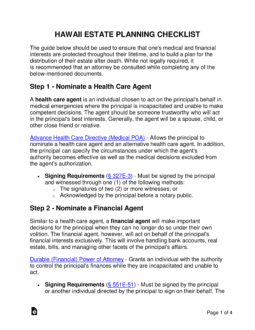Updated March 05, 2024
A Hawaii estate planning checklist is a guide for individuals planning their end-of-life affairs in preparation for incapacitation or death. Included in the checklist are documents that are imperative to the proper arrangement of one’s end-of-life preferences. The person seeking to prepare for such scenarios (referred to below as the “principal”) can designate a medical attorney-in-fact by completing an Advance Health Care Directive. The principal’s financial decisions will be outlined in a Durable (Financial) Power of Attorney. The principal can establish the administration of their estate following their death by creating a Last Will and Testament or a Revocable Living Trust.
How to Create an Estate Plan in Hawaii (6 steps)
- Nominate a Health Care Agent
- Nominate a Financial Agent
- Make a List of Current Assets
- Choose the Beneficiaries
- Create a Living Trust or Last Will and Testament
- Safely Store Documents
The guide below should be used to ensure that one’s medical and financial interests are protected throughout their lifetime, and to build a plan for the distribution of their estate after death. While not legally required, it is recommended that an attorney be consulted while completing any of the below-mentioned documents.
1. Nominate a Health Care Agent
A health care agent is an individual chosen to act on the principal’s behalf in medical emergencies where the principal is incapacitated and unable to make competent decisions. The agent should be someone trustworthy who will act in the principal’s best interests. Generally, the agent will be a spouse, child, or other close friend or relative.
Advance Health Care Directive (Medical POA) – Allows the principal to nominate a health care agent and an alternative health care agent. In addition, the principal can specify the circumstances under which the agent’s authority becomes effective as well as the medical decisions excluded from the agent’s authorization.
- Signing Requirements – Must be signed by the principal and witnessed through one (1) of the following methods:
- The signatures of two (2) or more witnesses; or
- Acknowledged by the principal before a notary public.[1]
2. Nominate a Financial Agent
Similar to a health care agent, a financial agent will make important decisions for the principal when they can no longer do so under their own volition. The financial agent, however, will act on behalf of the principal’s financial interests exclusively. This will involve handling bank accounts, real estate, bills, and managing other facets of the principal’s affairs.
Durable (Financial) Power of Attorney – Grants an individual with the authority to control the principal’s finances while they are incapacitated and unable to act.
- Signing Requirements – Must be signed by the principal or another individual directed by the principal to sign on their behalf. The signature is presumed to be authentic if acknowledged before a notary public.[2]
Financial Powers Allowed:
- Real Property[3]
- Tangible Personal Property[4]
- Stocks and Bonds[5]
- Commodities and Options[6]
- Banks and Other Financial Institutions[7]
- Operation of Entity or Business[8]
- Insurance and Annuities[9]
- Estates, Trusts, and Other Beneficial Interests[10]
- Claims and Litigation[11]
- Personal and Family Maintenance[12]
- Benefits from Governmental Programs or Civil or Military Service[13]
- Retirement Plans[14]
- Taxes[15]
- Gifts[16]
3. Make a List of Current Assets
4. Choose the Beneficiaries
5. Create a Living Trust or Last Will and Testament
After the beneficiaries have been chosen, the principal will need to create a document that outlines the manner in which their estate will be distributed. The document they use will be determined by their financial situation and personal preferences.
Last Will and Testament (‘Will’) – A legal document that allows the principal to dictate how their estate will be distributed upon their death. The principal, or “testator,” can designate specific items for each beneficiary (e.g., real estate, vehicles, stock). When the testator dies, the last will and testament will go through the probate process before being distributed to the beneficiaries.
- Signing Requirements – Must be signed by the testator and two (2) witnesses. If the testator is unable to sign, they may direct another individual to sign in their presence.[17]
Living Trust (Revocable) – Allows the principal to create an entity in which they can place their assets. The principal, or “grantor,” will name a trustee to control the assets during the principal’s lifetime. A living trust permits the principal to act as trustee and retain control over their assets. With a revocable living trust, the grantor can alter the provisions at any point before their death. When the principal dies, the assets designated to the trust will not go through the probate process and will be distributed to the beneficiaries without delay.
- Signing Requirements – The trustee will need to register the trust at a courthouse in the judicial circuit of the principal location of administration of the trust or, if the trust is specific to land only, of the location where the land is situated.[18]
6. Safely Store Documents
Hawaii Estate Planning Laws
- Advance Health Care Directive (Medical POA) – Title 19, 327E
- Durable (Financial) Power of Attorney – Uniform Power of Attorney Act
- Last Will and Testament – Title 30A, Article II
- Revocable Living Trust – Title 30A, Article VII


